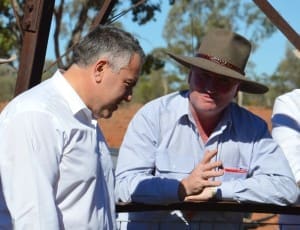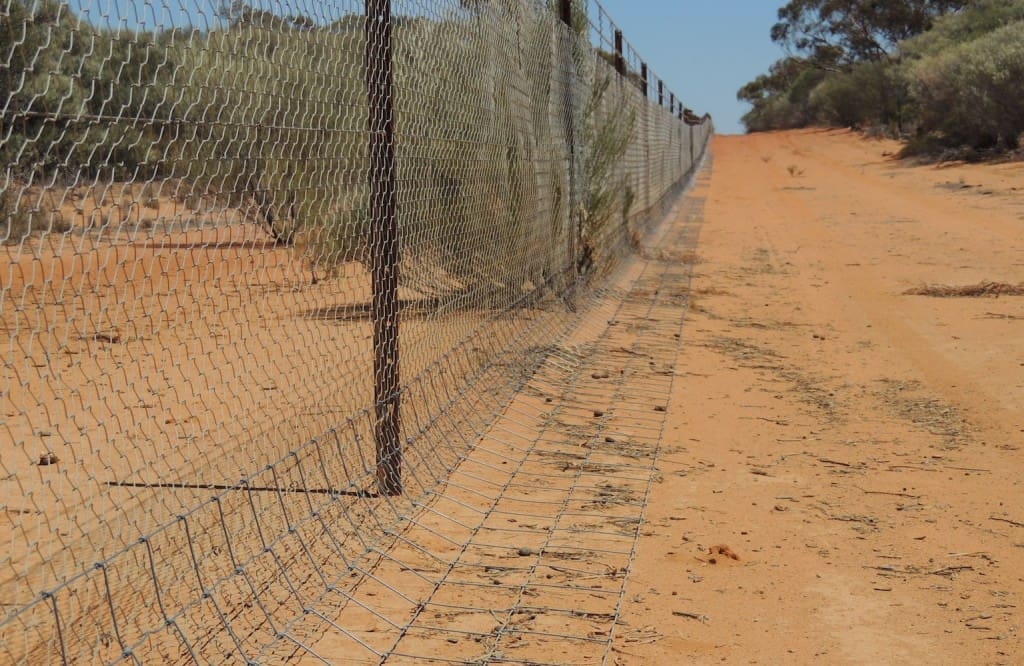Opinion

Treasurer Joe Hockey and Barnaby Joyce on a drought tour to western Queensland in September last year.
Here’s a little story about Jack and Diane. Two young farmers doing as best as they can. And if they sell $1.9 million of cattle and grain a year, or grapes and wine, or wool and lamb and their turnover is under $2 million then they have the benefit of record commodity prices and now have an overwhelming reason to invest in their farms to make it bigger for them and better for Australia.
From 1, July 2016, the fences they build are 100 per cent deductible in the first year. The water infrastructure and dams they put will also be immediately 100 per cent tax deductible. The silos and hay sheds they build can be written off over three years.
As of 7.30pm on Budget night, small items of plant and equipment such as the post-hole diggers, chainsaws, motorbikes, quad runners, cattle crushes, pumps, generators, welders, second-hand vehicles and other items that cost up to $20,000 and are used on the farm are instantly 100 per cent tax deductible.
With a record turnaround in prices for cattle, sheep, wool, grains and increasing prospects in wine, tropical fruits and citrus, they are also able to get a 5 per cent discount on their tax capped at $1,000 per year.
The Agricultural Competitiveness White Paper that is yet to come but is budgeted for will assist further in these two young farmers’ positions.
The Coalition has presided over one of the greatest turnarounds in soft commodity prices, so because of our six new live animal destinations and three new Free Trade Agreements, Jack and Diane are enjoying record prices for cattle, sheep and a dramatic turnaround in the Eastern Market Wool indicator, strong prices in citrus, wine and grape and a virtual mosh-pit of international buyers trying to purchase their product.
Jack and Diane have vastly better prospects in Australia now than they did in the John Mellencamp song.
At the same time the Farm Household Allowance will spend close to half a billion dollars over the forward estimates in regional areas, which is in fact a half billion dollar economic stimulus package for regional communities which are doing it tougher in the drought areas. This money is spent in local towns and businesses supporting regional communities. On top of this is the further recent announcement of a $35 million stimulus package for the communities at the epicentre of the drought, and a further $25 million on top of the $8.5 million already allocated for pest control for pests such as wild dogs and pigs.
This money is spent on such things as fencing material which underpins the businesses of rural suppliers and hardware stores.
Farmers doing it tough also have the benefit of being able to access further concessional loans above the $270 million already lent out.
And an extra $250 million has been made available for the next 12 months at 3.84% and 3.21%. This means that banks have to be competitive in the money they lend and farmers know that the government is partnering with them in replanting and restocking after the drought to assist the nation in the growth of the soft commodity base.
We also committed $20 million for social and mental health support in recognition that the people on the land are our most important asset and we must always look after them.
These measures are part of the $333 million drought package announced by the Prime Minister on the weekend.
Our attention to drought can also be seen in the Farm Household Allowance fortnightly support payment that is currently being received by over 4,800 farmers or their partners; and the 531 farm businesses that are accessing concessional loans.
For farmers are in Northern Australia, they will benefit from a $5 billion infrastructure program which in its initial announcement includes $100 million on beef roads so farmers can get their produce to market in more efficient ways.
We have an increase in exports of cherries and citrus. We have completed the Wheat and Barley Protocol for China. We have started, and are well on the way, in delivering a Country of Origin Labelling scheme that is simple, diagrammatic, reflects proportionality as to the amount produced in our country, and is compulsory. We have changed the Foreign Investment Review Board guidelines to give proper oversight to our most precious assets – the land we stand on and the food it produces – not only for our nation, but for so many others.
We have had problems with grapes into Vietnam in the past, but we now have major new markets for our wine and table grapes into Japan and Korea and a re-opening of the China market – significant markets that are making a difference. We are seeing signs of a turnaround in the wine industry with new contracts. We’ve opened up new markets for fruits, including lychees and mangoes. In livestock genetics we are also realising new opportunities, with better access for our bovine genetics into the US. We are working with industry to develop export strategies, so that our efforts achieve the best possible outcomes for farmers. We have also reformed the Research and Development Corporations for our wine and wine grape producers, as well as for our horticulture industries.
We have delivered three free trade agreements to give access to so many sections of agriculture — to China, Korea and Japan. And we have opened six new live animal markets: Egypt, Bahrain, Iran, Thailand, Cambodia and Lebanon. We’ve got kangaroo meat moving into Peru – taking some pressure off the Western districts where there are excessive numbers adding to the drought.
As already stated we’ve put major money on the table to control pests, including wild dogs. We’ve delivered the first major new programme in decades, to control this scourge that leaves sheep and cattle maimed or dead, destroying farm productivity. We have assisted in the delivery of on farm water infrastructure with $23 million for on-farm bores, piping and troughs, and invested a further $15.9 million in the capping and piping of bores in the Great Artesian Basin. We have started our dams programme, with $60 million for water infrastructure in Tasmania and funding for the Chaffey Dam in Tamworth. And we have funded the continued delivery of infrastructure in the Murray Darling Basin.
We have focussed on small exporters, and we have put into action our Biosecurity Rapid Response team, for incursions such as the Cucumber Green Mottle Mosaic Virus and Panama Disease. As I write, we are on the cusp of passing the Biosecurity Bill 2014 – the single largest legislative reform to Australia’s biosecurity system in more than 100 years.
This year’s budget delivers practical support to primary producers and encourages money to be spent on-farm to increase production, and now means that every farmer has even more incentive to invest in drought resilience over the long term. The accelerated depreciation measures for primary producers (for fencing, water infrastructure and fodder storage), the additional $20,000 instant write-off for small business, the cut in the corporate tax rate as well as the additional five per cent tax discount on profits including non-corporate entities, capped at $1,000, will make an immediate and profound difference to farming operations right across the nation.
We have in the budget the money for the further delivery of the Agricultural Competitiveness White Paper which will be announced once we have allowed the Australian farming community to absorb the significant budget measures announced this week.
We have already announced the first round for R&D For Profit grants to deal with pests such as parthenium weed and blackberries, but it also funds such programs as dairy extension research and invests in Australia’s white fish aquaculture industries. The projects funded in the first round will directly improve the profitability or productivity of Australian farms. Why is that? Because that was the key, non-negotiable criteria that I personally insisted upon.
We remain committed and are progressing well towards creating centres of excellence for agriculture, so that regional towns that live in and by the agriculture economy have the investment in their expertise and culture to provide career paths for young graduates to have a long term future in agricultural research and policy.
In some of the commentary it is said that the benefits for small business are not there because the profits are not there. I disagree with this because the profits for agriculture are there and our job is to accentuate the benefits to ensure the family farm is the cornerstone of Australian farming. And coming from a small family farming operation, my sympathy is firmly for the family farming business.
This is what the government has done thus far. People know in agricultural Australia that this government has made a real difference to their lives. And people in agricultural Australia can be affirmed in their view that this dedication will continue.


If farmers are spending again it is because prices have improved and has little to do with tax or the Govt.
How many farmers across Australia will have a “tax problem” in 2014-15? Not too many in Queensland I’d wager. Many will remain in a tax loss situation while the drought persists and derive NO benefit from this budget “concession”